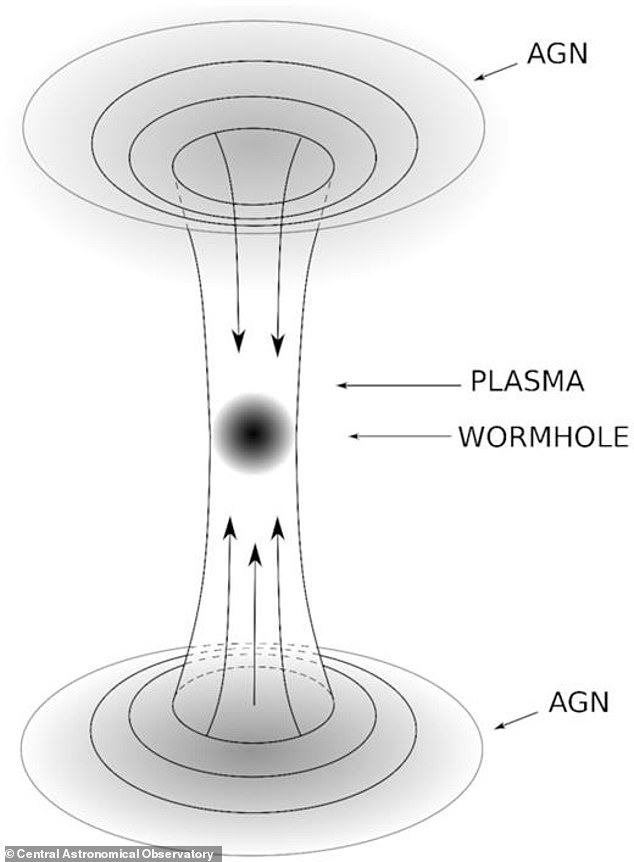Astrophysicists have suggested that some supermassive black holes could be the entrances to the craters of cosmic worms that can transport spacecraft to distant parts of the universe.
- Very energetic galaxies with an AGN are “candidates” for wormholes
- Scientists believe that these galactic cores connect distant points in time and space
- They are “ traversable wormholes ” rather than a supermassive black hole
- Looking for evidence of extreme temperatures can prove their existence
Astrophysicists have suggested that some of the supermassive black holes at the center of galaxies may actually be wormholes connecting two distant parts of the universe.
In his theory of general relativity, Albert Einstein predicted the existence of wormholes connecting two points in space or time, but these have not yet been discovered.
Experts from the Central Astronomical Observatory in Russia now believe that “black holes” at the center of some very bright galaxies (known as AGNs or AGNs) could be the entrances to these wormholes.
While these wormholes are theoretically traversable, which means spacecraft can travel through them, they are surrounded by intense radiation, which means that humans are unlikely to survive the flight, even in the most rugged spacecraft.
Some galaxies have “AGNs” at their center – a phenomena-like supermassive black hole with double jets of matter emanating from the electrodes of the accretion disk
Worm holes and black holes are very similar, in that they are very dense and have an extraordinary force of attraction for objects of their size.
The difference is that nothing can exit a black hole after crossing its “event horizon”, whereas any object that enters the mouth of a wormhole will theoretically exit from its other “mouth” elsewhere in the universe.
The researchers concluded that material entering one mouth from the wormhole could collide with material entering the other mouth from the wormhole at the same time.
This collision would cause balls of plasma to expand from both mouths of the wormhole at the speed of light, and at temperatures around 18 trillion degrees Fahrenheit.
At such heat, the plasma will also produce gamma rays with energies of 68 million electron volts, which allows Some NASA observatories – such as the Fermi Space Telescope – to detect the explosion.

The closest active galactic nucleus is located in the constellation Centauri A, about 13 million light years from Earth, in the constellation Centauri (pictured)
The new study, published in the Monthly Notices of the Royal Astronomical Society, examined the type of energy and radiation produced by AGNs.
The closest AGN is in the Centaurus A galaxy, which is about 13 million light years from Earth in the constellation Centaurus.
Active galactic cores are usually surrounded by rings of plasma known as accretion disks and can emit strong jets of radiation from their electrodes.
The energy bursts produced by the accretion disks are not close to the heat emitted by the collisions inside the wormholes.
However, the researchers suggest that if they discover what appears to be an AGN that emits high-energy spherical gamma rays, it might not be a kernel duct nucleus at all but an entrance to a wormhole.

The Russian team believes that these AGNs are wormholes in another part of the universe and that they can be detected by observing the very hot and intense energy jets caused by the collision of material from both sides of the wormhole into the throat.
The researchers go further, noting that these wormholes are likely to be “passable,” meaning that spacecraft could theoretically travel through them.
“ We must understand that we know very little about the internal structure of wormholes, and moreover, we do not know for sure if they exist at all, ” said study author Mikhail Piotrovich. Motherboard.
He said that if humans at any time traveled to these distant galactic cores, they would open a new path for potential spaceflight or even a way to travel in time.
However, it is surrounded by intense radiation, and the closest one is 13 million light-years away, so it is unlikely that any human will be able to use one to travel the universe anytime soon.
The results have been published in the journal Monthly Notices of the Royal Society.

“Reisliefhebber. Onruststoker. Popcultuurfanaat. Kan niet typen met bokshandschoenen aan.”